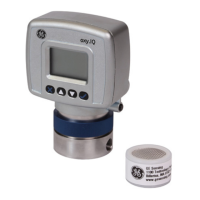
Do you have a question about the GE Baker Hughes oxy.IQ and is the answer not in the manual?
| Brand | GE |
|---|---|
| Model | Baker Hughes oxy.IQ |
| Category | Analytical Instruments |
| Language | English |
Instructions for registering the product online to receive support and updates.
Overview of customer support services offered, including training and product repairs.
Information on accessing product warranty and sales terms via the company website.
Explains the meaning of notes, cautions, and warnings used throughout the manual.
Covers user responsibilities for safety codes and requirements for European customers.
Details safety standards and regulations for operating auxiliary equipment.
Provides warnings about equipment movement and safe practices in operational areas.
Emphasizes the need for trained and competent personnel for operation and maintenance.
Lists essential safety gear for operators and maintenance staff.
Outlines measures to prevent unauthorized access and operation of the equipment.
Information regarding Waste Electrical and Electronic Equipment (WEEE) and RoHS directives.
Provides a general overview of the oxy.IQ Panametrics Oxygen Transmitter's function.
Details certifications enabling the transmitter's use in hazardous environments.
Lists various typical industrial applications where the oxy.IQ is utilized.
Highlights the key technical features and benefits of the oxy.IQ system.
Discusses sample handling systems and potential interference gases affecting sensor performance.
Step-by-step guide for the physical installation of the oxy.IQ unit.
Instructions for connecting the oxy.IQ transmitter's electrical wiring.
Detailed procedure for installing or replacing the oxygen sensor.
Description of the front panel interface and its components.
An overview of the menu structure for navigating and configuring the device.
General five-step process for initial setup and calibration.
Guide to choosing the appropriate measurement range for the output signal.
Procedure to calibrate the 4-20 mA analog output for accuracy.
Steps for performing an air calibration, crucial for new sensor installation.
Instructions for calibrating the sensor using a known span gas concentration.
Accessing and configuring calibration parameters.
Instructions on how to check the remaining operational life of the installed sensor.
Settings to customize the display, including O2 parameter and contrast.
Configuration options for the analog output and error reporting.
How to define conditions that trigger on-screen warnings and alarms.
Selecting the signal output during specific error conditions.
Procedure and passcode required to access advanced service functions.
Guide to running diagnostic tests to check the transmitter's status and performance.
Technical specifications relevant for intrinsically safe installations.
Specifications for non-incendive and general purpose installations.
Covers general specifications like materials, ranges, accuracy, and dimensions.
Details and explanation of the information presented on the product label.
Reference to the drawing detailing physical dimensions and installation layout.
Reference to the drawing for standard cable assembly specifications and wiring.
Reference to the drawing for IS cable assembly specifications and wiring.
Reference to drawings illustrating various connection and wiring options.
Reference to the system schematic diagram for electrical connections.
Details of the EU Type Examination Certificate for ATEX compliance.
Information pertaining to the ATEX IECEx MAM Ex Certificate.
Certificate confirming compliance with Canadian hazardous location standards.
Certificate confirming compliance with US hazardous location standards.
Details of the IECEx Certificate of Conformity.
Important safety information and certification details for the transmitter.